I’m in the mood for the unusual today, so I thought I’d showcase a few combs that are flamboyant variations of the ones we usually see.
These silver and gold kanzashi from the Meiji era are over-the-top attachments to silver pins. They have 16-petal chrysanthemums, leaves, gold branches, and fringe. They were sold on Trocadero for a ridiculous price because I know this dealer. ;-) I didn’t buy them, though. :-(
This tortoiseshell comb boasts 3 carved shell cameos, one of Athena and two of Flora. It sold for $1295 on Ruby Lane, even with two slightly broken tines and a seperation in the scrolled ornamentation at the top. The dealer thought it was French, 1860. I am not sure. With the craze surrounding archeological discoveries that took over Victorian England, it might be English. I’m undecided, but I love it.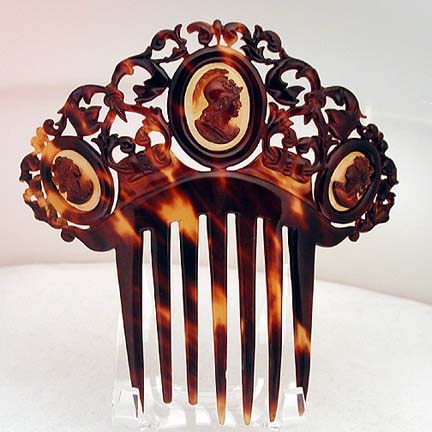

This one I am buying. It’s a Victorian Algerian, c. 1870. As aluminum was discovered in 1827, when this was made, the metal was more valuable than gold. Alas, today, the materials in this comb are worth about 35 cents, but I had never seen one like it, and I had to have it. :-) The leaves are acanthus leaves, after Cesar’s headpiece. The chains are silver, and the beads are turquoise-colored glass. I guess one wore this with a toga-like white gown.
This Edo tortoiseshell comb with a silver- and gold-plated copper frame, decorated with coral beads, sold on ebay for $1000 on Oct 15.
I thought this celluloid comb had humor and originality. It is English, c. 1890, and sold on ebay as part of a 7-piece lot.
And last, becuase I must, a flamboyant 19th-century tiara of 18K gold with diamonds, emeralds, rubies, amethysts, garnets, and topaz. I loved all the colors. :-) It is available for sale at a jewelry store on Madison Ave. in Manhattan, which was featured in a NOVA special on diamonds, as having one piece of the French crown jewels.
Category Archives: French Hair Comb
Metamorphosis
Metamorphosis, a poetic strategy whereby plants and animals fused with the human form, was commonly used in art nouveau jewelry, perhaps most famously by Rene Lalique. Jewelers created mystical creatures, who emerged from nature erotically, as leaves and dragonfly wings were teased into looking like parts of the body. In comb making, parts of an animal or human body were elongated into being functional parts of the comb.
This comb was the star of the Lalique / Japanese comb-comparison exhibit in Hakone, Japan. The museum wouldn’t send the catalog outside of Japan. I had to ask my friend Shigeru-san’s brother to get it for me and send it. But, oh my God. I never knew this comb existed.
It is an honor for me to present what I believe to be the first Internet images of Lalique’s comb, “Metamorphosis.” It is ivory, with gold trim, pearls on the gold. The trim is faceted to the ivory by nails on the side and gold loops ended by lapis hearts. In it, a woman is born out of leaves: Rodin on a comb, an astonishing marriage of art and functional design.



My Little Mystery
About a year ago, I bought this little ivory comb on Ebay for around $24. I liked it. It was unusual. No one else wanted it. So, c’est la. As I was researching the web one day, I came across this little interesting picture from the Victoria and Albert Museum in London. The picture was called “Designs for a Pendant and Comb.” The text read, “René Lalique (1860-1945), Design for a comb (right), Pen, ink and gouache, Museum no. E.838-1949. The comb was possibly designed to be made from ivory or horn. The latter is an unusual material for jewellery but one that Lalique made frequent use of, especially in his many ornamental combs.” Here was the drawing.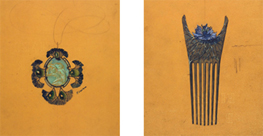
Here is what I bought.

It has what I believe to be a Japanese signature. We know Lalique was heavily influenced by the Japanese comb makers. My little comb even has the same number of tines as the drawing. I have no idea if the maker ever saw Lalique’s drawing, but when I look at my comb, I am reminded of that wonderful children’s novel, “From the Files of Mrs. Basil E. Frankweiler.” It’s a mystery.
Some Lovely Things on Ebay
There have been some lovely things on ebay recently.
A wonderful 14K gold griffin on a silver base, attached to a tortoiseshell comb sold for $550 on Sept. 27. It has a diamond in its mouth, diamonds on the wings, and a ruby cabachon eye. You may refer to Item #170151496226.

A beautiful Meiji silver-and-gold kanzashi set depicting a bowl, vase, and spoon sold for $465 on Sept. 26. Only one is pictured here so you can see the closeup. You may refer to Item #300153292268.
This Victorian garnet tiara hinged on a tortoiseshell comb just sold for $308 on Sept 24. Excellent price for such a lovely star-laden tiara design.You may refer to item #170150463040.
This beautiful Edo kogai stick sold for $660 on Sept 17. It is made of tortoiseshell and decorated with apricot flowers. If you look at the closeup, you can see that little bell flower with the pistels. These painted flowers have the same design as the carved flowers on both shell kanzashi, and the bakelite kanzashi from those Japanese wedding sets they made in the 1940s. You may refer to item #110168679851.
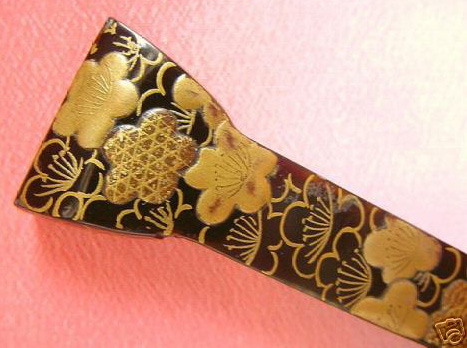
This ivory Edo kogai stick with gold maki-e paint and inlaid jade and coral sold for $300 on Sept. 17. You may refer to Item #330164680560.
This lovely carved shell floral design on a Meiji set went for $152 on August 30. The stick in between the kogai pieces is wood. There are bug bites on the shell kushi, and that brings the price down considerably. In perfect condition, this would have gone much higher, but I thought $152 was an excellent price for this.
This is a gorgeous piece. The Meiji tortoiseshell kushi depicts waves and is inlaid with pearl. Excellent Condition. It sold for $646 on Sept 22. You may refer to Item #300151918225.
And finally, for today :-), this beautiful Victorian ivory comb sold for $355 (I lost, sadly) on Sept 21. You may refer to Item #290161590846.
Holding Hands
One of the most beautiful innovations of art nouveau design occurs when an artist translates the relationships between animals and plants into a piece of jewelry: one flower petal leaning over to touch another, birds in an embrace. The relationship is then formed not only into art, but also into function. Here are two combs, which illustrate this beautifully.
On the left is a pair of fan-shaped leaves by Louis Aucoc, c.1900. They are made of green plique-à-jour enamel with small rose-cut diamonds in the veins. It sold for $32,400 on April 25, 2006, in New York. On the right, two silver cranes embrace to make this imaginative comb by Hugue. As you can see, the legs of the crane function as the comb, which sold for 1200 GBP on February 22, 2006 in London. Both came from Sothebys.
Hair Comb Exhibit at the Lalique Museum in Hakone, Japan
After the opening up of trade routes to Japan, Edo combs were introduced at the Paris exhibition of 1867. They took the European art world by storm and began a craze in France called Japonisme . Western artists noticed the strong Japanese relationship with nature, which produced jewelry that was at once delicate and powerful. Rene Lalique was heavily influenced. He chose comb motifs (swallows, hanging wisteria) and materials (horn), which were common in Japan but shunned in Europe at the time.
It is interesting to compare his famous work Two Swallows with a Stalk of Oats c. 1906-1908, carved horn gold and diamonds, with a Meiji kanzashi of plover birds. In Swallows, Lalique takes the Japanese motif to a new level of inventive design and composition. 
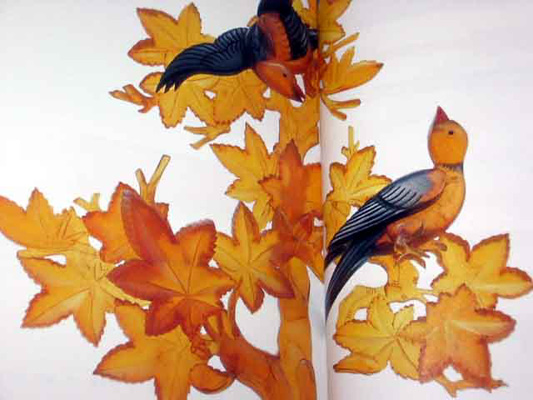
In this comb housed at the RijksMuseum in Amsterdam, Lalique makes Guelder rose flowers on stems of translucent horn. Apparently, they are so fragile that the flowers of diamond clusters seem to be bending the leaves.
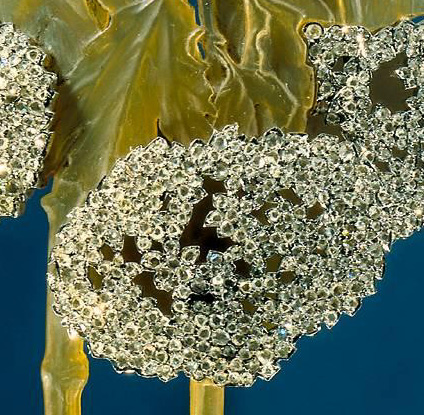
No Lalique post would be complete without an orchid. This one lives in a museum in Lisbon.
From June 23 to Nov 25 2007, The Lalique Museum in Hakone Japan will have a Special Exhibition: The Charm of Hair Ornaments – Lalique’s Combs and Japanese Traditional Kushi.” I don’t know that these particular pieces will be showcased, but there will be 20 Lalique combs made with his own hands on display. 
Haute Couture
I recently watched a special on PBS called The Secret World of Haute Couture. It showed some of the customers who actually bought these dresses and wore them at opera galas, charity balls (an oxymoron) and parties where they’d meet dignitaries or royalty. One woman, an heir to the Guinness fortune, said, “If a celebrity has worn a gown. I don’t want it. It’s been done.”
This had me rolling with laughter as I looked at my own drawers full of discount JJill catalog loose cotton clothing that I buy on ebay. :-) I guess none of these women sat in their vegetable gardens, picked stuff, washed it with a hose, and just sat on the ground eating things beside the neighborhood rabbits, who were eating things, too. :-)
At any rate, I thought some of the dresses of the Fall 2007 Haute Couture collections in Paris were gorgeous. It doesn’t matter that you don’t fit into the one the model wears. You just order, and they make the dress, alter the design, and do what they must so it will fit you. And all for only $100,000. ha! Well, it’s because each dress is made by the great ateliers of Paris and designed by a genius.
Here are two short dresses from Valentino.

Two red evening dresses from Valentino.

Two to-drop-dead-for evening dresses from Valentino. Look at the hand beading on these. Can you imagine the skill it took to make them?

Here is a rose dress from Valentino and a black evening dress with a fabulous white cape from Galliano for Dior.

I’ll end this post with these dresses from John Galliano, right out of a fairy tale.

कंघी
For more haute couture style, please examine
Some Lovely Things on Ebay
There have been some lovely silver and coral kanzashi selling for excellent prices on ebay. Very unique objects, such as a man-with-hat and an instrument, were attached to the hairpins. The Meiji man-with-hat went unsold at $350, whereas the Edo kanzashi of a Japanese traditional instrument with fish carved into the hairpin itself sold for $390. The shell bird kanzashi with gold makie went for $293. 


Two elaborately carved Meiji tortoiseshell kushis also sold, but at very different prices. The first one had a complex design of fans and flowers, no bug bites, and was signed. The second one had an elaborate floral design of chrysanthemums and peonies, a few bug bites, and was not signed. There was a significant price differential. Kushi #1: $577 on July 14; Kushi #2: $127.50 on July 15.

There was also a lovely brass Victorian tiara, which went unsold at a starting bid of $275.
A beautifully balanced design marks this lacquer over shell signed Meiji set, which sold for $283.
And I will end this post with two more museum-quality blond tortoiseshell kanzashi ornaments of plover birds flying over the sea.

To Delight The Eye
I liked these. :-)
Edo comb, possibly Japanese hibiscus? 18th century.
Liturgical comb of Boxwood inlaid with geometric marquetry & studded with silver. Italy, c.1500. The Italians were world renowned for intarsia wood craft during this period, the most famous example being The Gubbio Stuiolo at the Metropolitan Museum of Art.
Here is a tiara from Rene Lalique, 1903-1904.
This is a lovely tortoiseshell comb by Alexander Parkes, England. c. 1870.
This winged ornament sat atop a tiara, which would be worn to the opera, perhaps a performance of Wagner “Die Walkure” (The Valkyrie). It is made of tortoiseshell, diamonds and pearls. France. c. 1900. 
And finally, because I must… ;-) An English rose-cut diamond and pearl tiara, c. 1860. To die for. :-)
C’est la vie, peeps! Have a great month. :-)
Some Lovely Things on Ebay
There have been some absolutely gorgeous things sold recently on ebay. A French silver and gold tiara with seed pearls, c. 1810, had rings in the back perhaps for a veil, and a few metal comb prongs in the back, too, to hold it in place. The seed-pearl microbeading reminds me of antique French purses. It went for $1025. I must admit I cried because I didn’t win. This is one of those once-in-a-lifetime finds for tiara lovers.


This beautiful plique a jour peacock comb with a seed pearl and art glass inserts had the DRGM mark. It stands for Deutsches Reich Gebrauchsmuster (German Reich Registered Design), and certifies that the piece was made before 1945. It sold for $1017.
Plique-a-jour is an enameling process. The enamel is laid between thin raised metal lines and heated. The finished piece has transparent enamel held between the thin metal wires. Making jewelry translucent followed the artistic movements of the day, as Tiffany’s favrile glass burned with light and painting became impressions of light.
Two French art nouveau horn hair pins with seed pearls sold at an Ebay Live Auction for $516.31. I don’t know for sure, but they looked like Louis Aucoc to me. What value is in a name? Here is a comparison between the hair pins and an Aucoc comb at the Tadema Gallery, listed in the 2500 to 5000 UKP range. Do we have a match?
This lovely French horn art nouveau comb went for $102.50. It was a modest, unsigned comb, but beautiful in its subtlety and shadow. I thought it was a fabulous buy.
This French horn comb with rhinestone beads and bats, c. 1910, went for $679.35 at an Ebay Live Auction on April 23.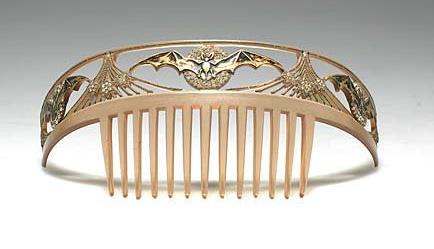
This George Jensen comb, c. 1909-1914, went unsold at $4000. It was tortoise shell with sterling silver flowers and 5 red garnet stones.
Finally, here are three lovely kanzashi. The first has a beautiful arrangement of plum, bamboo, pine, tortoise and crane, Japanese symbols of luck. It sold for $283. The second has pine, plum, and sea bream. The tub implies purfication. c. late Edo to early Meiji. Price: $341.67. The third had coral blossoms on an ivory branch, and sold for $202.50.


Happy Collecting, Peeps!








